Written by: Haroon Shuaib
Posted on: May 26, 2023 |  | 中文
| 中文
Mukhtar Begum, Rani and Farida Khanum at Rani's launch press conference
No other actress from Pakistani celluloid has been as ferociously independent, driven, and claimed as much adulation from critics and been so popular as Rani. She was born in a rather poor Arain family of Mozang, Lahore in 1946. Her father, Haq, happened to be driver of one of the most prominent celebrity couples of their time, legendary poet, playwright, and dramatist, Agha Hashar Kashmiri and his classical ghazal singer and actress wife, Mukhtar Begum. This is the same Mukhtar Begum who was so skillful in scouting talent that she gave a young budding singer Allah Wasai, a screen name, Noor Jehan, when she spotted her acting and singing talent. She also mentored Naseem Begum, who sang some of the most memorable melodies as a playback singer, before her untimely death. When Mukhtar Begum, elder sister of the great ghazal singer of the Indian subcontinent, Farida Khannum, saw Haq and his wife Bali’s daughter, whom they had named Nasira, she asked the parents to let her take this child under her wings. The poor couple agreed. After the creation of Pakistan, Mukhtar Begum settled in Karachi and started training the girl to be a singer, and changed her name from Nasira to Rani, literally meaning ‘Queen”. Unlike her benefactor, Rani never had the talent to be a vocalist, and her heart was in learning dance and acting on the big screen.
Mukhtar Begum launched Rani in the film industry as Rani Mukhtar in 1962, when she had barely turned 16. Mukhtar Begum recommended her to the seasoned film director, Anwar Kamal Pasha, who gave Rani a minor role of a dancer in his film Mehboob in 1962. For the next four years, Rani Mukhtar worked in several films in small roles and while her beauty and dancing skills impressed the cine goers, none of the films had Rani in a central role or proved to be a box office hit. There came a time when she was declared jinxed. This bad spell came to end in 1965 with Saaz Aur Aawaaz, Rani’s first film as a leading lady opposite Waheed Murad. The movie was a success, and there was no looking back for Rani.
Rani’s expressive eyes, sensuous curves and superb dancing skills soon caught the eyes of another great filmmaker of Pakistan, Hasan Tariq. He selected Rani for an important role in his 1967 blockbuster Dewar Bhabi. The film went on to be a golden jubilee hit at the box office. Rani had become the super star she had always wanted to be. It was around this time that she dropped Mukhtar from her name and was reunited with her family in Lahore, while the parent who had adopted her, Mukhtar Begum, was in England getting medical treatment. Rani was now flooded with offers for many films, both Urdu and Punjabi. In 1968 Rani starred in a Punjabi film Chan Makhna, opposite Inayat Hussain Bhatti. The film had the song Chan meray makhna which many years later became famous again when Shazia Manzoor sang it and film star Nirma performed on the song during a television show. Equally comfortable in both Urdu and Punjabi due to her life experiences, some of Rani’s most memorable and successful films are: Dil Mera, Dhadkan Teri (1968), Mera Ghar Meri Jannat (1968), Anjuman (1970), Tehzeeb (1971), Babul (1971), Naag Mani (1972), Umrao Jan Ada (1972), Surraiya Bhopali (1976), Parakh (1978), Behan Bhai (1979), Badnaam (1980) and Sona Chandi (1983) . In 1968 she got a special Nigar Award for her performance in Mera Ghar Meri Jannat, and in 1971 a Nigar Award for best actress for her role in Babul. In 1983 another Nigar Award for best actress for Sona Chandi.
It would be fair to say that Rani started many trends in Pakistani film industry. She was one of the first heroines to actually carry the weight of women-centric films on the big screen. She perfected essaying the role of a reluctant courtesan, and two of the most prominent films of her career, Anjuman and Umrao Jan Ada, were centered around characters of a woman caught in the web of unfortunate circumstances. Rani was also the first heroine in the subcontinent to play the fantasy role of a serpent who turns into a woman. She played this role in the not so successful Nache Nagan Baje Been (1965) and Naag Muni (1972), which was of moderate success. This plot was later adopted in many films and television productions, both here and across the border in Indian film and television industry. It goes without saying that Rani, with her big mesmerizing eyes and superb dancing skills was the most perfect choice to essay the fantasy role of a snake, who turns into a woman through magical powers.
In a career spanning over three decades, Rani worked opposite a wide range of heroes including the older brigade such as Santosh, Ijaz, Kaifi, Inayat Hussain Bhatti and Kamal, and then with many actors from the golden period of Pakistani cinema such as Waheed Murad, Mohammad Ali, Shahid, Nadeem, and even Rahat Kazmi (Aap ki Khatir in 1980). She also worked with heroes known more for their comic characters such as Ali Ijaz and Rangeela. At a time when society was still considered largely traditional and women’s freedom was considered a taboo subject on cinema screens, Rani channeled her inner strength to portray some very unconventional roles. Her films such as Ik Gunah Aur Sahi (1975), Begum Jan (1977), Seeta, Mariam, Margaret (1978), Aurat Raj (1979), Hye Ye Shohar (1980), and Kinara (1982) were a clear departure from how a heroine had to be a role model. Due to her bold choices, Rani can truly be labelled as the first feminist heroine of Pakistan’s film industry.
One other distinct feature of Rani was her mastery in getting a song picturized. Her dancing skills and her melodramatic acting made her lip syncing to some of the finest melodies of Pakistani cinema a treat to watch. From Tan topay waron (Naag Mani), and Jo Bacha tha (Umaro Jan Ada), to Izhar Bhee Mushkil Hay (Anjuman) , Rani seems to have done justice to Noor Jehan’s vocal prowess. Her performance equally suited the vocals of Runa Laila for whom Rani lip synced songs such as Dil Dhadkay (Anjuman), Aap Dil Ki Anjuman (Anjuman) and Kaate Na Kate (Umrao Jan Ada). For Naheed Akhtar’s memorable songs for Surraiya Bhopali such as Jiss Taraf Aankh Uthaon Teri Tasweeran Hain and Tha Yaqeen Kay Aain Gi, Rani was undoubtedly the perfect choice. In the film Khushboo of 1979, she performed on a romantic song Main Jiss Din Bhula Doon Tera Pyar Dil Say, with her co-star Shahid, with whom she had the most hits. Despite not having a singing talent herself, Rani had a great sense for good music. This is evident from the fact that when Hassan Tariq planned to make “Umrao Jan Ada’, he wanted to take Khalil Ahmed as the music director. Rani insisted that he ask Nisar Bazmi to make music for the film. Hasan Tariq, who was married to Rani at the time, resisted, but Rani threatened that if Bazmi was not composing music for the film, she would not act in it. Hasan Tariq eventually relented and every song of that film went on to become evergreen.
Rani, unfortunately, was not as smart when it came to the matters of heart. Besides rumored romances with her co-actors Kaifi, Kamal, and Mohammad Ali, she married thrice in her life. Her first marriage was with Director Hasan Tariq, who had already been married twice. He considered Rani his muse, and they did some of their greatest work together. They married in 1970 and separated in late seventies. With him Rani had her only child; her daughter Rabia. Rani then married Mian Javed Qamar, a cinema owner from Faisalabad, but this marriage proved to be short lived. His family refused to accept Rani, and when in 1982 Rani was first diagnosed with cancer, Mian Javed left her after learning of her illness. While going through her treatment in London, Rani met cricketer Sarfaraz Nawaz, who took care of her and later they got married. On their return to Pakistan, Sarfraz Nawaz decided to enter politics in 1985 and Rani managed his election campaign, canvassing from door to door. She was successful in getting him elected as a member of Punjab’s provincial assembly. Rani by then had completely moved away from films, but became the first leading lady of the big screen to turn to acting on television. In the early ‘90s, she acted in two successful drama serials. Her roles as Nafeesa Begum in ‘Khwahish’ opposite Azam-ul-Haque, and as Ashi Bee in Faraib opposite Ajab Gul, are still unforgettable.
Soon after she got her daughter Rabia married in 1992, not only did Rani’s marriage to Sarfraz Nawaz come apart, but the dreaded disease also returned. Her failing health made it impossible for her to take on any new projects on television, and on 27 May 1993 she breathed her last in Karachi at the age of just 46 years.



You may also like: